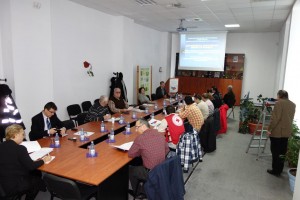- Date: 11-12 December 2013
- Place: Eforie (Romania)
- Participants: 21 persons
For the training were invited experts from Black Sea municipalities (10 mayors), Romanian Red Cross, Constanta Inspectorate for Emergency Situations and Civil Protection.
The training was organized in two-days training sessions. Trainers were Dr. Eng Constantin Ionescu National Institute for Earth Physics General Manager and Dr.Eng. Emil Sever Georgescu Scientific Director of National Institute for Research And Development in Construction, Urban Planning And Sustainable Spatial Development “URBAN-INCERC”.
In the first day the agenda comprise subjects regarding the Earthquake Early Warning System: motivation, principle of operation and implementation status, DACEA as a pilot project for EWS implementation, etc. During the first day was also organized a visit at the Dobrogea Seismological Observatory and a full chapter was dedicated to ESNET findings and results presentation (webportal, movies and other resources).
In the second day Dr.Eng.Emil-Sever Georgescu, also director of the Laboratory for Seismic Risk Assessment and Construction Activities, present the followings topics:
- Seismic hazard and disaster potential in Dobrogea county: earthquake, landslides and tsunami
- Seismic risk and vulnerability in Romania and in the Black Sea Basin
- Specialized response in case of emergency, post-seism actions, evacuation, recover and
reconstruction.
Courses outcomes
Upon completion of Introduction to Disaster Management and Capacity Building Start-Up Trainings participants were able to:
- Define and describe disaster management, hazard, emergency, disaster, vulnerability, and risk,
- Identify and describe the types of natural and non-natural disasters and the implications of disasters on your region and environment,
- List and describe the main hazards to which your region is, or may be, vulnerable,
- Define the various phases of the disaster management cycle,
- Explain the importance of disaster mitigation and disaster preparedness,
- Describe how disaster management can be integrated into public policy and how planning and design of infrastructure should take into account the vulnerability of communities,
- Develop and write an emergency operations plan (EOP),
- State and explain the importance of the Community-Based Approach to education and
public awareness, - Describe how a community-based action plan for disaster management can be
actively implemented, - Describe how and why training personnel to acquire skills and knowledge are essential
in mitigating the impact of disasters, - Recognize the contribution and participation of volunteer agencies,
- Define the contents of a school-based programme on disaster management,
- Define and explain how culture contributes to people’s response to education and public awareness programmes,
- Compare the importance of indigenous knowledge in education and public awareness on disaster management,
- Define Emergency Management Systems (EMS),
- Identity how the EMS assists in hazardous material management, emergency medical services, and response and recovery operations,
- Explain the role of the media in disaster management,
- State the advantages and disadvantages of using Remote Sensing Systems (RSS) in disaster management,
- Identify the components involved in emergency medicine,
- Describe a suitable infrastructure and procedures in accessing emergency medicine services,
- Identify the main communicable diseases common in disaster situations; the risk factors that increase the likelihood of an outbreak and ways of preventing/minimizing such outbreaks,
- Explain the importance of water sources and the minimum standards for water quality and quantity,
- Describe processes to monitor and evaluate vector control measures and environmental health programmes in emergency situations,
- State the impacts of a disaster on society,
- Develop contingency plans to minimize food distribution problems in the post-disaster period,
- Assess the impacts of disaster on people’s income, earning capacity and overall social welfare,
- Identify the stages of disaster recovery and associated problems,
- Identify and list the most vulnerable groups in disaster and post-disaster times,
- Describe briefly how we can reduce the effects of disasters on vulnerable groups.

